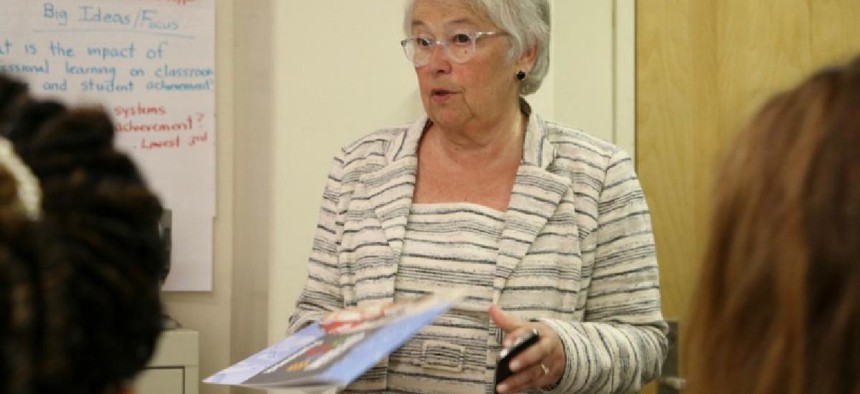Chancellor Carmen Fariña expects to consolidate a growing number of very small schools next year, which she has asked superintendents to identify, she told city lawmakers Monday.
In a reversal of the previous administration’s policy of creating new small schools, Fariña has announced plans over the past year to combine 25 small schools, arguing that by pooling resources the merged schools are able to offer more advanced classes and enrichment programs. While she did not have an exact count on Monday, Fariña said her conversations with superintendents suggest that many more small schools could benefit from mergers.
“It will certainly probably be more than what we did this year, based on what I’m hearing,” Fariña told reporters after a three-hour City Council hearing on the mayor’s proposed $23.1 billion education spending plan for next school year, where she also answered questions about school safety, transgender students, and calls to make lunch free for all students.
The schools that Fariña has targeted for consolidations so far have been very small, typically with 200 students or fewer, and often low-performing as well. (The plans call for 12 mergers, including one set of three schools.) On Monday she added some other factors that might make schools ideal candidates for mergers: they share a building; one principal is retiring, making it easier for the other to take over; one school is higher performing than the other; or one school has resources, like science equipment or honors classes, that could benefit the other.
When two or three schools consolidate, the money saved by paying for only one principal and administrative staff “goes back into classrooms,” Fariña said, perhaps to fund additional elective classes or after-school programs. She is also considering removing individual grades from schools — such grades six to eight in a school that includes the elementary and middle grades — if just part of a school is under-enrolled, Fariña added.
After Fariña meets with every superintendent, a special merger unit within the education department will create a list of potential consolidations, which officials will discuss with people at each school and the city’s education policy board will vote on, she said.
“Nothing will happen without a lot of discussion,” Fariña told the council.
Here are some other highlights from the chancellor’s testimony and her briefing with reporters:
Fariña defended the city’s school safety record, saying schools are safer than ever.
The mayor’s critics have mounted a fierce campaign featuring TV commercials and rallies (including one planned for Tuesday at City Hall) to convince the public that schools have become more dangerous under his watch. The charter school advocacy group Families for Excellent Schools has said that schools saw more violent incidents last year (using state figures that the city disputes), and more weapons were seized from students.
But Fariña flatly denied those charges on Monday, adding that she has found that schools labeled “persistently dangerous” by the state do not warrant that label. (State policy makers are considering revising how schools earn that label.)
“I happen to think school safety is better than it’s ever been,” she told reporters. “Even one case is too many, but it’s certainly not at the level where I’d say our schools are unsafe.”
She said the city is ahead of the curve in serving transgender students, though its bathroom policy must be revisited.
The Obama administration released guidelines last week on how school districts should protect the rights of transgender students — more than two years after New York City issued similar recommendations.
“We’re so far ahead of the rest of the country,” Fariña told reporters, trumpeting the education department’s new liaison for LGBTQ students. She said the liaison has already trained many superintendents and schools’ parent representatives on LGBTQ-related issues, though several council members said one liaison is not enough.
However, the city might still have to update its transgender-student policy to conform with the new federal guidelines. While the city recommends that those students be allowed to use private bathrooms if they request them, the federal rules say they must be permitted to use whichever bathrooms match their gender identity.
She wouldn’t commit to expanding a free-lunch program, despite pressure from lawmakers.
City Council members continued to press the city to expand a free-lunch program in middle schools to include all students, citing advocates who say an additional 120,000 students would eat the $1.75 lunches if they were free. A council report said that more middle-school students ate lunch as a result of the program, while the city did not lose any federal funding — a concern the mayor has raised.
The council estimates that expanding the program to all students would cost $8.75 million next year. Fariña said Monday that the city is “looking into” the possibility of adding money for free lunches, but that “it’s all a matter of priorities.”
Schools could start getting money for students who arrive mid-year.
It frustrates principals every year: Latecomer students enroll after Oct. 31, when school budgets are set based on enrollment counts, leaving schools to serve extra students without extra funding.
Fariña told lawmakers Monday she’s aware of the issue and is considering possible solutions, such as re-calculating a school’s budget mid-year if it enrolls a certain number of latecomers.
“Any child who comes to your school after October 31 is like a blank slate,” Farina said. “They don’t carry money.”
However, she noted that many schools also lose students during the year but still retain the funding tied to them.
This article was first published on May 17 on Chalkbeat New York.


